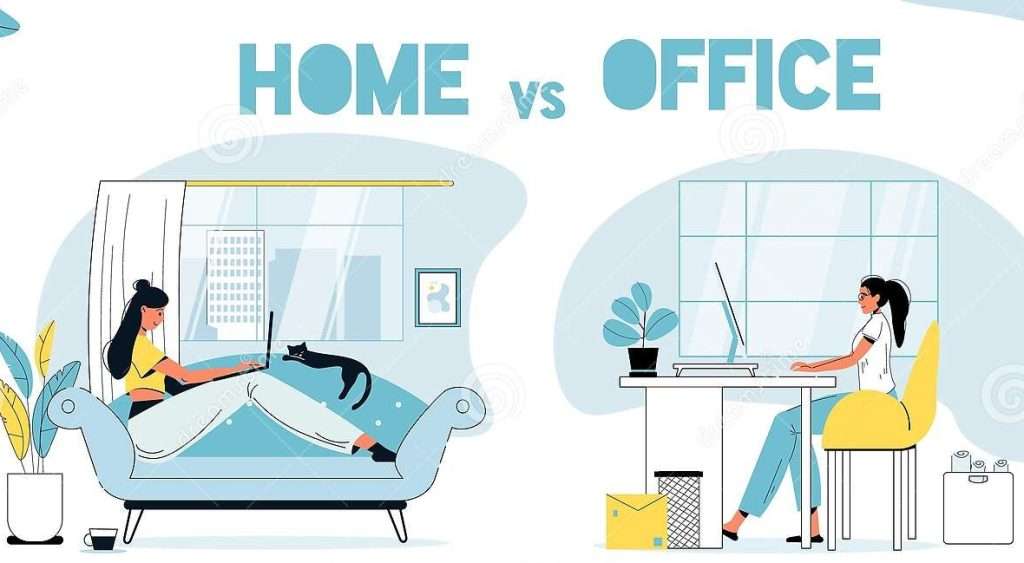Work from Home vs Work from Office: The Strong Pros and Cons 2023

Work from Home vs Work from Office Theme: The concept of Work from home is the best way to better balance your professional and personal responsibilities. For example, you can take care of a sick child during the day without needing to take time off from work. Over 60% of Americans are working from home due to the ongoing COVID-19 pandemic, according to a recent survey by the National Bureau of Economic Research. Some employees have reported advantages such as greater work-life balance and cost savings on commuting, while others have experienced isolation and burnout. Advantages of Working from home: Increased flexibility: One of the biggest advantages of working from home is the ability to create a schedule that works best for you. For example, if you are a morning person, you can start your workday earlier and finish earlier in the day. Reduced commute: When working from home, you don’t need to spend time and money commuting to an office, which can be a huge time saver and cost reducer. Improved work-life balance: Working from home allows you to better balance your professional and personal responsibilities. For example, you can take care of a sick child or run errands during the day without needing to take time off from work. Increased productivity: Without the distractions of an office environment, some people find that they can be more focused and productive when working from home. For example, a quiet home office with minimal interruptions can lead to better concentration and quicker task completion. Better health: Remote work allows to have more control over their physical environment, you can have better posture, better lighting, less noise, and other environmental factors, reducing the risk of health issues such as back pain, headaches, and eye strain. Cost savings: Working from home can also save money in the long run. For example, you don’t need to spend money on gas or public transportation to get to the office, and you can save money on things like coffee and lunch. Environmentally Friendly: Remote work reduces the carbon footprint of transportation. According to a study by the environmental consulting firm, Carbon Trust, remote work can reduce carbon emissions by up to 20%. Disadvantages of Working from home: Isolation and lack of social interaction: Without the daily interactions that come with working in an office, some people may feel isolated and lonely. This can also lead to feelings of burnout and reduced job satisfaction. Difficulty separating work and personal life: When working from home, it can be challenging to separate work and personal life, which can lead to longer work hours and a lack of work-life balance. For example, working in a home office may make it difficult to “switch off” from work when the workday is over. Difficulty collaborating and communicating: Remote work can make it more difficult to collaborate and communicate with coworkers, clients, and other stakeholders. For example, it can be harder to have spontaneous conversations or to provide hands-on support when working remotely. Lack of structure and accountability: Without the structure and routine of an office environment, some people may find it harder to stay organized and motivated. For example, working from home can lead to procrastination and lack of focus if an employee doesn’t set a clear schedule. Distractions: It is easy to get distracted from household chores, family members, or other things when working from home. For example, home-schooling children while working can prove to be a big distraction. Unfavourable working conditions: Lack of proper office equipment and workstations can lead to discomfort, pain, and long-term health issues. Security risks: When working from home, it is harder to protect company data and equipment from security risks such as hacking or physical theft. It is also harder to ensure that employees are properly trained and equipped to handle sensitive data when working remotely. Advantages of working from the office: Improved collaboration and communication: Working in an office allows for face-to-face interaction and spontaneous conversations, which can lead to better teamwork and increased productivity. For example, having a quick conversation with a colleague can help to clarify a task or solve a problem more quickly than sending an email. Increased accountability and structure: In an office setting, there is a set schedule and routine that can help employees stay on task and motivated. For example, regular team meetings can help to keep everyone informed and on track. Access to office resources: When working in an office, employees have access to resources such as office equipment, supplies, and technology that can make their work more efficient. For example, having a large monitor can help with better visualization and faster editing of documents. Professional development and growth opportunities: In an office environment, employees have more opportunities for professional development, such as mentoring and training programs. For example, attending company-wide meetings and events can help employees to stay informed about company developments and new industry trends. Sense of community and belonging: being part of an office environment can foster a sense of belonging, camaraderie, and motivation. For example, team-building activities and office events can help build stronger relationships among coworkers. Clarity of roles and hierarchies: An office environment clearly defines roles, responsibilities and hierarchies, leading to better communication, delegation, and decision-making. Improved company culture: An office environment can also help to foster a positive company culture by creating a sense of community among employees and promoting a shared sense of purpose. Disadvantages of Working from Office: Here are a few disadvantages of working in an office, with examples: Commuting: A long or difficult commute can be time-consuming, stressful, and expensive. For example, sitting in traffic for a long time can make an employee arrive at work tired and stressed. Lack of flexibility: In an office setting, employees are typically required to follow a set schedule, which may not work for everyone. For example, a parent with young children may not be able to work traditional office hours. Distractions: An
